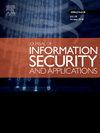使用可解释的深度学习实现强大的android恶意软件检测模型
IF 3.7
2区 计算机科学
Q2 COMPUTER SCIENCE, INFORMATION SYSTEMS
Journal of Information Security and Applications
Pub Date : 2025-08-17
DOI:10.1016/j.jisa.2025.104191
引用次数: 0
摘要
日益增长的Android恶意软件威胁需要有效且值得信赖的检测机制。本文研究了基于网络流特征的Android恶意软件检测和分类的可解释深度学习模型的鲁棒性。在CICAndMal2017数据集上评估了三种深度学习架构——DNN、1D-CNN和BiLSTM,其中BiLSTM在未见样本上取得了最佳性能。使用LIME和SHAP对模型决策进行分析,以确定有影响和可能可操纵的特征。利用领域知识,根据特征的抗逃避性对其进行分类,重点放在TCP标志和初始窗口大小等稳健指标上。仅使用这些鲁棒性特征对模型进行再训练,导致了最小的性能下降,同时显著提高了可解释性和规避能力。在未见数据集上,BiLSTM模型在恶意软件检测和分类方面的f1得分分别为70.90%和62.84%,AUC得分分别为73.39%和79.96%。在去除弱特征后,重新训练的检测模型保持了71%的f1得分,分类模型达到了57%,这表明鲁棒性可以在性能没有重大损失的情况下得到提高。这些结果突出了透明和可靠的人工智能驱动的网络安全解决方案的潜力,特别是在逃避常见的对抗性环境中。通过强调可解释性和鲁棒性,这项工作有助于建立在不断发展的威胁环境中平衡性能与信任的模型。本文章由计算机程序翻译,如有差异,请以英文原文为准。
Towards a robust android malware detection model using explainable deep learning
The growing threat of Android malware demands effective and trustworthy detection mechanisms. This paper investigates the robustness of explainable deep learning models for Android malware detection and classification using network flow features. Three deep learning architectures — DNN, 1D-CNN, and BiLSTM — were evaluated on the CICAndMal2017 dataset, with BiLSTM achieving the best performance on unseen samples. Model decisions were analyzed using LIME and SHAP to identify influential and potentially manipulable features. Using domain knowledge, features were categorized based on their resistance to evasion, with emphasis on robust indicators such as TCP flags and initial window sizes. Retraining models using only these robust features resulted in minimal performance degradation while significantly improving explainability and resilience to evasion. On the unseen dataset, the BiLSTM model achieved a 70.90% F1-score for malware detection and 62.84% for classification, with AUC scores of 73.39% and 79.96%, respectively. After removing weak features, the retrained detection model maintained a 71% F1-score, and the classification model achieved 57%, demonstrating that robustness can be improved without major loss in performance. These results highlight the potential for transparent and dependable AI-driven cybersecurity solutions, particularly in adversarial settings where evasion is common. By emphasizing explainability and robustness, this work contributes towards models that balance performance with trust in evolving threat landscapes.
求助全文
通过发布文献求助,成功后即可免费获取论文全文。
去求助
来源期刊

Journal of Information Security and Applications
Computer Science-Computer Networks and Communications
CiteScore
10.90
自引率
5.40%
发文量
206
审稿时长
56 days
期刊介绍:
Journal of Information Security and Applications (JISA) focuses on the original research and practice-driven applications with relevance to information security and applications. JISA provides a common linkage between a vibrant scientific and research community and industry professionals by offering a clear view on modern problems and challenges in information security, as well as identifying promising scientific and "best-practice" solutions. JISA issues offer a balance between original research work and innovative industrial approaches by internationally renowned information security experts and researchers.
 求助内容:
求助内容: 应助结果提醒方式:
应助结果提醒方式:


